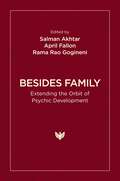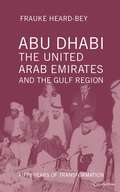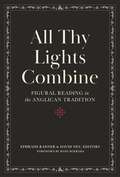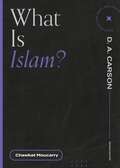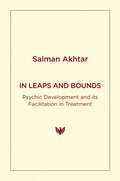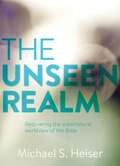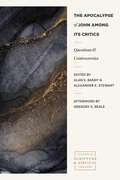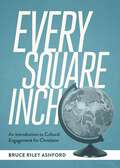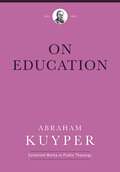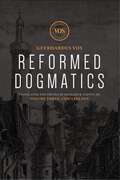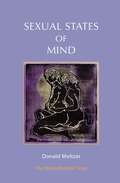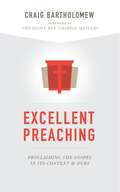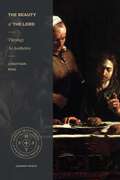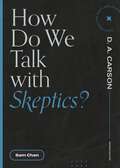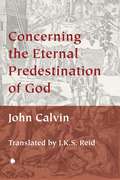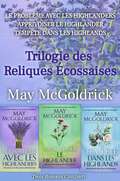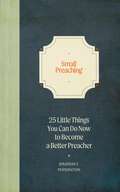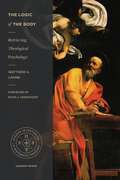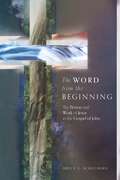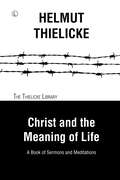- Table View
- List View
Besides Family: Extending the Orbit of Psychic Development
by Salman Akhtar, April Fallon, and Rama Rao GogineniCollectively authored by psychoanalytic colleagues of multiple nationalities, ages, genders, religious origins, and meta-theoretical persuasions, Besides Family goes far beyond the usual orbit of parents and siblings. Casting a wide net, the contributors look at a number of key figures who may affect an individual's psychic development and functioning. Each character receives a full chapter which highlights both the beneficial and adverse possibilities within these relationships. The book opens with a chapter on nannies, tracing the centuries-old history in the West and focusing on four renowned psychoanalysts: Sigmund Freud, Sandor Ferenczi, John Bowlby, and Wilfred Bion. Next comes a discussion of neighbours, using material from religious texts, fiction, and poetry. This is followed by a chapter on childhood playmates and friends, which examines the nature of friendship and how it develops across the lifespan. School teachers come next, using literature on teacher-student relationships synthesised with psychoanalytic developmental theory. Clergy is the next subject of discussion, blending Judeo-Christian religious customs with psychoanalytic developmental theory. The developmental significance of adolescent peers is examined next using a blend of neurophysiology, endocrine studies, behavioral observations, social-cultural vectors, and psychoanalytic insights. A discussion of lovers and the myriad ways in which romantic relationships mirror early development is the penultimate chapter. The book ends on the role of mentors and the evolution of the mentor-mentee relationship, taking into account the impact of age, race, and gender. The authors integrate material from history, anthropology, sociology, religion, literature, and film studies alongside vignettes from clinical practice and day-to-day life to bring theory to life. This fascinating exploration is essential reading for practising clinicians and trainees to broaden their understanding of the impact of the wide network that surrounds us all.
Abu Dhabi, the United Arab Emirates and the Gulf Region: Fifty Years of Transformation
by Frauke Heard-BeyThe unexpected decision of the British Government in January 1968 to withdraw its military and diplomatic protection from the Gulf catapulted the region into the limelight. For the following five decades the historian Dr. Frauke Heard-Bey was best placed to observe subsequent developments in the Gulf, having joined her husband David, a petroleum engineer, in Abu Dhabi in 1967. Through her role over decades in the Centre for Documentation and Research (now the UAEs National Archive), Frauke Heard-Bey made use of its archives about the Gulf, while taking every opportunity to travel in the area and immerse herself in the local environment. The work covers a broad spectrum, including the formation of the UAE in 1971, the subsequent development of this federation, the first oil crisis and geopolitical repercussions, urbanisation, labour migration, electoral systems, trade, the changing way of life and its implications for traditional loyalties in the Gulf states and Oman. The results of much of this work (which rely little on secondary sources) are collected in this volume, parts of which have been printed in hard-to access journals, while others are published here for the first time.
All Thy Lights Combine: Figural Reading in the Anglican Tradition
by Ephraim Radner David NeyWe do not simply interpret God's word. His word interprets us. Figural interpretation has been a trademark of Anglican devotions from the beginning. Anglican readers—including Tyndale, Cranmer, Hooker, and Lewis—have been figural readers of the Bible. By paying attention to how words, images, and narratives become figures of others in Scripture, these readers sought to uncover how God's word interprets all of reality. Every verse shines the constellation of God's story. Edited by David Ney and Ephraim Radner, the essays in All Thy Lights Combine explore how the Anglican tradition has employed figural interpretation to theological, Christological, and pastoral ends. The prayer book is central; it immerses Christians in the words of Scripture and orders them by the word. With guided prayers for morning and evening, this book invites readers to be re--formed by God's word. Become immersed in the riches of the Anglican interpretive tradition.
What Is Islam? (Questions for Restless Minds)
by Chawkat MoucarryHow to love your Muslim neighbor. Islam is the second--most popular and fastest--growing religion in the world. Islam and Christianity share some common commitments, but there are crucial differences. However, the greatest barrier to dialogue is that Christians and Muslims often misunderstand each other. Do you understand Islam? In What Is Islam?, Chawkat Moucarry compares the teachings of Islam and Christianity on the most essential issues, such as the Bible, God, Jesus, sin and forgiveness, Muhammad, and God's kingdom. Moreover, Moucarry dispels the many myths and misconceptions that both religions hold about the other, paving the way for charitable discussion. Understand how the gospel is good news for everyone. The Questions for Restless Minds series applies God's word to today's issues. Each short book faces tough questions honestly and clearly, so you can think wisely, act with conviction, and become more like Christ.
The Roots of William Tyndale's Theology
by Ralph S WerrellWilliam Tyndale is one of the most important of the early reformers, and particularly through his translation of the New Testament, has had a formative influence on the development of the English language and religious thought. The sources of his theology are, however, not immediately clear, and historians have often seen him as being influenced chiefly by continental, and in particular Lutheran, ideas. In his important new book, Ralph Werrell shows that the most important influences were to befound closer to home, and that the home-grown Wycliffite tradition was of far greater importance. In doing so, Werrell shows that the apparent differences between Tyndale's writings from the period before 1530 and his later writings, in the period leading up to his arrest and martyrdom in 1526, are spurious, and that a simpler explanation is that his ideas were formed as a result of an upbringing in a household in which Wycliffite ideas were accepted. Werrell explores the impact of humanist writers, and above all Erasmus, on the development of Tyndale's thought. He also shows how far Tyndale's theology, fully developed by 1525, was from that of the continental reformers. He then examines in detail some of the main strands of Tyndale's thought - and in particular, doctrines such as the Fall, Salvation, the Sacraments and the Blood of Christ - showing how different they are from Luther and most other contemporary reformers. While Tyndale, in his early writings, used some of Luther's writings, he made theological changes and additions to Luther's text. The influences of John Trevisa, Wyclif and the later Wycliffite writers were far more important. Werrell shows that without accepting the huge influence of the Wycliffite ideas, Tyndale's significance as a theologian, and the development of the English Reformation cannot be fully understood.
In Leaps and Bounds: Psychic Development and its Facilitation in Treatment
by Salman AkhtarSalman Akhtar presents three rich essays brimming with psychoanalytic theory on personality development and how such knowledge enhances treatment. Essay 1 starts at the earliest infancy and takes the reader all along the path past adolescence. It addresses key developmental landmarks, including: Establishing a satisfactory parental bond Moving towards autonomy and independence Acquiring a moral sense Consolidating identity. Essay 2 picks up after adolescence. It addresses the psychosocial challenges characteristic of young adulthood, midlife, and old age, such as: Assuming the role of a wage-earner and "house-holder" Enjoying sex, love, and marriage Downsizing and retiring from one's job Dealing with the deaths of friends and family and facing one's own mortality. Essay 3 builds upon the theory that has gone before and examines how a deepened understanding of psychic development can inform the clinician's approach. With an emphasis on development as a lifelong process, this essay provides clear guidelines for facilitating such growth, including: Creating psychic space for thinking Helping the patient find words for inner experiences Validating the patient's reality Enhancing the sense of personal agency in the patient. The complex tapestry woven by these three essays is extended by a prologue and an epilogue. The prologue opens with the "pre-self" - events before birth that impact on who we become. The epilogue discusses the "post-self" - how we "live on" as memories held by those who knew us. In Leaps and Bounds deepens the understanding of the nuances of human development. It is key reading for practising and trainee psychoanalysts and psychoanalytic psychotherapists to enhance their clinical practice. It is highly recommended for all enquiring minds looking to expand their knowledge of what makes us who we are.
The Unseen Realm: Recovering the Supernatural Worldview of the Bible
by Michael S. HeiserOver 175,000 copies sold. In The Unseen Realm, Dr. Michael Heiser examines the ancient context of Scripture, explaining how its supernatural worldview can help us grow in our understanding of God. He illuminates intriguing and amazing passages of the Bible that have been hiding in plain sight. You'll find yourself engaged in an enthusiastic pursuit of the truth, resulting in a new appreciation for God's Word. Why wasn't Eve surprised when the serpent spoke to her? How did descendants of the Nephilim survive the flood? Why did Jacob fuse Yahweh and his Angel together in his prayer? Who are the assembly of divine beings that God presides over? In what way do those beings participate in God's decisions? Why do Peter and Jude promote belief in imprisoned spirits? Why does Paul describe evil spirits in terms of geographical rulership? Who are the "glorious ones" that even angels dare not rebuke? After reading this book, you may never read your Bible the same way again.
The Apocalypse of John Among its Critics: Questions and Controversies (Studies in Scripture and Biblical Theology)
by Alan S. Bandy Alexander E. StewartShould Christians be embarrassed by the book of Revelation? The Revelation of John has long confused and disturbed readers. The Apocalypse of John among Its Critics confronts the book's difficulties. Leading experts in Revelation wrestle honestly with a question raised by critics: Should John's Apocalypse be in the canon? (Alan S. Bandy) Was John intentionally confusing? (Ian Paul) Was John a bully? (Alexander E. Stewart) Did John delight in violence? (Dana M. Harris) Was John a chauvinist? (Külli Tõniste) Was John intolerant to others? (Michael Naylor) Was John antisemitic? (Rob Dalrymple) Did John make things up about the future? (Dave Mathewson) Did John advocate political subversion? (Mark Wilson) Did John misuse the Old Testament? (G.K. Beale) Engaging deeply with Revelation's difficulties helps the reader understand the book's message—and respond rightly. The book of Revelation does not need to be avoided or suppressed. It contains words of life.
Every Square Inch: An Introduction to Cultural Engagement for Christians
by Bruce Riley AshfordJesus is Lord over everything. So his lordship should shape every aspect of life. But what impact does faith really have on our day-to-day existence? And how should we, as Christians, interact with the culture? In Every Square Inch, Bruce Ashford skillfully navigates such questions. Drawing on sources like Abraham Kuyper, C. S. Lewis, and Francis Schaeffer, he shows how our faith is relevant to all dimensions of culture. The gospel informs everything we do. We cannot maintain the artificial distinction between "sacred" and "secular." We must proclaim Jesus with our lips and promote him with our lives, no matter what cultural contexts we may find ourselves in.
On Education (Abraham Kuyper Collected Works in Public Theology)
by Abraham KuyperKuyper on the Divine Purpose for Education Among Abraham Kuyper's many accomplishments was his founding of the Free University of Amsterdam, where he also served as president and professor of theology. This collection of essays and speeches presents Kuyper's theology and philosophy of education, and his understanding of the divine purpose of scholarship for human culture. Included are convocation addresses given at the Free University, parliamentary speeches, newspaper articles, and other talks and essays on the topic of education. Much of the material deals with issues still being debated today including the roles of the family and state in education, moral instruction, Christian education, and vouchers.
Reformed Dogmatics: Christology
by Geerhardus J. VosLike books, people can become 'classics.' Great in their day, but richer and more fulfilling with time. Not yet a classic, Vos's never-before-published Reformed Dogmatics is more like a lost Shakespeare play recently discovered. --Michael Horton Until recently, Reformed Dogmatics was only available in its original Dutch. But now you too can access Geerhardus Vos' monumental work of systematic theology. This brand-new English translation was edited by biblical theologian and Vos expert, Richard B. Gaffin, Jr. In Volume Three, Christology, Vos discusses: The person of Christ Christ's two natures The incarnation The work of Christ Christ's death and resurrection The nature of Christ' sacrifice Christ's offices And more
Sweeter Than Honey, Richer Than Gold: A Guided Study of Biblical Poetry (Reading the Bible as Literature)
by Leland RykenThis is the second of a projected six-volume series called Reading the Bible as Literature (the first volume being How Bible Stories Work). An expert at exploring the intersection of the Bible and literature, Ryken shows pastors and students and teachers of the Bible how to appreciate the craftsmanship and beauty of biblical poetry and how to interpret it correctly. Dr. Ryken goes one step further than merely explaining the genre of poetry-he includes exercises to help students master this rich literary treasure.
Birds of Kangaroo Island: A Photographic Field Guide
by Chris BaxterRegional bird field guides are few and far between in South Australia and Chris Baxter's photographic guide to the birds of Kangaroo Island is the stand-out in this genre. This comprehensive account covers all 267 bird species recorded on the Island or offshore over the seas. It builds on the annotated list produced by the same author in 1989 and revised in 1995. The photographs provided by some of Australia's most highly regarded photographers beautifully illustrate the detailed descriptions of the birds, their habits, habitats, breeding, status, abundance and distribution on the Island. In addition there are recommendations on where to look for each species, with cautions about not getting too close to endangered birds and their nests. Chris Baxter has called on a lifetime of bird watching on Kangaroo Island and observations from visitors and residents to present an attractive field guide that is a must for all birdwatchers from casual observers to serious ornithologists.
Sexual States of Mind
by Donald MeltzerA ground-breaking psychoanalytic study on sexuality which maintains its originality today, forty-five years after its first publication. The book is a revision of psychoanalytic theory, starting with the work of Freud himself and including Melanie Klein's contributions on the early Oedipus Complex and the Depressive Position. But more than that, it is a metapsychological study of sexuality which provides a different perspective from more well-known ones that relate simply to a descriptive or behavioural point of view. In differentiating adult sexuality from infantile sexuality and polymorphism and perversion, taking unconscious phantasy and the notion of the primal scene as the pivotal point, Meltzer proposes a unified theoretical and clinical model which has proved of particular help in the field of the psychopathology of addictions and perversions.
Excellent Preaching: Proclaiming the Gospel in Its Context and Ours
by Craig G. BartholomewThe goal of preaching is to let the powerful message of the Bible penetrate the lives of your congregation. A well-crafted sermon can help to bridge the gap between biblical context and contemporary application. In Excellent Preaching, Craig Bartholomew explains why we need to be acquainted with both the context of Scripture and the context in which we preach. Good contextualization is hard work, but Bartholomew shows that it can be done. Practical, accessible, and rooted in years of preaching experience, this short book helps preachers connect the message of the text to everyday life.
The Beauty of the Lord: Theology as Aesthetics (Studies in Historical and Systematic Theology)
by Jonathan KingWhy is God's beauty often absent from our theology? Rarely do theologians take up the theme of God's beauty—even more rarely do they consider how God's beauty should shape the task of theology itself. But the psalmist says that the heart of the believer's desire is to behold the beauty of the Lord. In The Beauty of the Lord, Jonathan King restores aesthetics as not merely a valid lens for theological reflection, but an essential one. Jesus, our incarnate Redeemer, displays the Triune God's beauty in his actions and person, from creation to final consummation. How can and should theology better reflect this unveiled beauty? The Beauty of the Lord is a renewal of a truly aesthetic theology and a properly theological aesthetics.
The Web of Friendship: Nicholas Ferrar and Little Gidding
by Joyce RansomeA portrait of Nicholas Ferrar and his family, to whom he dedicated his ministry, with a focus on his background and the education and experiences that shaped that ministry and the circumstances that brought them to Little Gidding. This book appeals for its detailed account of a family's life together as well as the spiritual aspirations that made their household a community. Later generations appealed to their example both for its mission and its method. Not only does Ransome describe the man and the family in a way that brings them alive but also encompasses both their strength and their human frailties and indicates their contemporary and future significance. The book is aimed at both an academic and general audience of readers interested in history, religion, education, and family relationships including the role of women.
Pastor, Jesus Is Enough: Hope for the Weary, the Burned Out, and the Broken
by Jeremy WritebolIn Pastor, Jesus Is Enough, Jeremy Writebol invites pastors to hear the words of the risen Jesus in the seven letters within Revelation 2–3: Pastors love Jesus most Pastors suffer Pastors teach and tell the truth Pastors become like Jesus Pastors abide in Jesus Pastors find their value in Jesus Pastors repent The exhortations in Revelation 2–3 are directed to churches. But they also exhort pastors. In these letters, Jesus draws near to pastors—whether hurting or straying—and reminds them of his sufficiency. In these warnings and promises, Jesus has hard words for pastors. But they are words of life. Most of all, Jesus urges pastors to keep their focus on him. Being enough is exhausting. But pastor, the good news is that you cannot be enough. Because only Jesus is enough.
How Do We Talk with Skeptics? (Questions for Restless Minds)
by Sam ChanShare your faith and keep your friends. You want your non--believing friends to be brothers and sisters in Christ. But how do you talk about Jesus without driving them away? When do you talk? When do you stay quiet? In How Do We Talk with Skeptics?, Sam Chan shows you how to walk the tightrope by offering ten wise tips to keep the balance right. Listen well. Speak persuasively. Learn hospitality. Gently reveal the holes in your friend's worldview. Gain wisdom on when to speak and when to listen. With Chan's help, you can keep your friends while being a faithful witness for Christ. The Questions for Restless Minds series applies God's word to today's issues. Each short book faces tough questions honestly and clearly, so you can think wisely, act with conviction, and become more like Christ.
Concerning the Eternal Predestination of God
by John CalvinAlthough he wrote comprehensively on a wide range of doctrinal issues, it is Predestination with which Calvin is most associated today. In this, his definitive text on the subject, he outlines fully a doctrine he feels has been wilfully misinterpreted to the detriment of the Church. Readers will witness Calvin masterfully arguing his points, wrestling with the scriptures, and fully engaging in the polemical world of sixteenth-century theological debate as he refutes the views of three of his chief detractors. J.K.S. Reid's widely praised translation preserves the nuances of Calvin's thought and the strength of his rhetoric, while his introduction offers a critical examination of Calvin's theological argument.
Trilogie des Reliques Écossaises (Trilogie des reliques écossaises)
by Jan Coffey May McGoldrickLe Problème Avec les Highlanders Alexander Macpherson, guerrier des Highlands, veut retrouver sa femme farouchement indépendante. Kenna Mackay a un don étrange pour la guérison et des projets qui n'incluent pas le mariage. Une bataille d'esprit s'ensuit. Mais alors que les passions s'enflamment entre eux, un méchant sans cœur se rapproche, et deux amants obstinés se retrouvent enfermés dans une lutte entre le mal et le pouvoir de l'amour éternel... Apprivoiser le Highlander (Finaliste du prix Rita !) Innes Munro a la capacité de lire le passé d'une personne simplement en la touchant, mais son don a un prix élevé : sa liberté. Conall Sinclair, le comte de Caithness, porte les cicatrices et les marques de fouet des donjons anglais, mais les blessures qui s'enveniment à l'intérieur de lui lui causent une douleur encore plus grande. Tous deux sont réticents à se laisser approcher, mais aucun ne peut nier la passion grandissante qui couve sous chaque regard, chaque contact. Tempête dans les Highlands Miranda MacDonnell est en fuite. Porteuse de la mystérieuse relique héritée de sa mère, elle est désormais traquée par un ennemi implacable qui ne reculera devant rien pour la retrouver. Embarquée sur un navire, elle est prise dans une tempête et fait naufrage sur la mythique île des Morts avec le célèbre corsaire Black Hawk. Alors que les deux naufragés tombent amoureux, des forces anciennes sont à l'œuvre, rassemblant les quatre détenteurs du pouvoir de la relique pour une bataille finale où le bien devra vaincre les forces du mal...
Small Preaching: 25 Little Things You Can Do Now to Make You a Better Preacher
by Jonathan T. PenningtonIs bigger always better? It's not often that we hear the virtues of the small. Our culture teaches that bigger is better--and that includes church ministry and preaching, too. But what if rather than swinging for the fences, preachers focused on improving their sermons through small habits, practices, and exercises? What if smaller is better? In a world where "small" isn't always celebrated, Jonathan T. Pennington provides Small Preaching, a short book of simple tips that can have revolutionary effects over time. Pennington offers preachers 25 words of wisdom that will help shape their preaching for the better.
The Logic of the Body: Retrieving Theological Psychology (Studies in Historical and Systematic Theology)
by Matthew A. LaPine"Do not be anxious about anything." When it comes to stress and worry, that's all we really need to say, right? Just repent of your anxiety, and everything will be fine. But emotional life is more complex than this. In The Logic of the Body, Matthew LaPine argues that Protestants must retrieve theological psychology in order to properly understand the emotional life of the human person. With classical and modern resources in tow, LaPine argues that one must not choose between viewing emotions exclusively as either cognitive and volitional on the one hand, or simply a feeling of bodily change on the other. The two "stories" can be reconciled through a robustly theological analysis. In a culture filled with worry and anxiety, The Logic of the Body offers a fresh path within the Reformed tradition.
The Word from the Beginning: The Person and Work of Jesus in the Gospel of John
by Bruce G. Schuchard"And the Word became flesh" John's Gospel famously opens with a poetic prologue about the Word. However, after these initial verses, the theme of God's Word incarnate seems to fade. The silence is only apparent. In The Word from the Beginning, Bruce G. Schuchard reunites John's prologue with the rest of his Gospel. What Jesus does in the Gospel embodies who Jesus is in the prologue. Jesus's words and actions reveal and unfold his unique identity as the Word. Jesus is indeed God's Word enfleshed. This theological reading of John's Gospel unifies Jesus's identity, words, and work, opening up implications for Johannine Christology.
Christ and the Meaning of Life: A Book of Sermons and Meditations (Thielicke Library)
by Helmut ThielickeIn this series of sermons, first delivered over radio and television in Germany during the 1960s, Helmut Thielicke wrote about the true meaning of Christian festivals such as Good Friday, Easter and Pentecost. He saw deeply into the mystery, despair, and confusion of life in his time and spoke a truly prophetic word to Christians that still resonates today. As Thielicke meditates on Christmas, the reader will understand anew how light shines in the darkness of this world. As he preaches about Christ's suffering on the cross, humanity's suffering is given meaning; and, in talking of death, he gives us encouragement to live in hope. Christ and the Meaning of Life explores subjects as far apart from each other - and as close together - as rehabilitation and retribution, beauty and terror, and love and brutality. Here Thielicke faces the fearsome questions that plague humanity and brings the Christian Gospel to bear on each of them with a clarity and persuasiveness that echoes in these troubled times.
